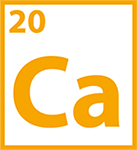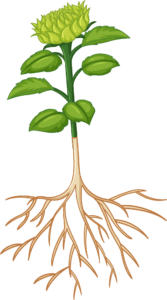Symbol: Ca
Availability: available to plants as the ion Ca2+
Calcium functions

It is essential for cell division and the growth and development of the apices and roots


Ca is fundamental for fruit quality; it improves fruit firmness and fruits shelf-life.

It acts as an enzyme activator and as secondary messenger; it assists in various plant functions like nutrient uptake and changes in cell status to help the plant react to the impact of stresses.

It prevents sensitive calcium physiological disorders like tip burn, blossom end rot, bitter pit and fruit cracking.
Calcium (Ca) is an essential macronutrient in plants, with concentrations in the shoot ranging from 0.1 to over 5% of dry weight. These values reflect both Ca availability in the environment and the contrasting Ca requirements of different plant species. It thereby exhibits a dual function, both as a structural component of cell walls and membranes and as intracellular second messenger. The uptake, distribution, and storage in the plant therefore need to be tightly regulated to comply with both tasks.
Calcium is taken up by roots from the soil solution as a cation (Ca2+) and once inside the plant it is delivered to the shoot via the xylem. Its uptake involves its entry from soil solution into root cells through Ca2+-specific ion channels followed by entry into shoot cells, and this process is influenced by metabolism and temperature. Phytohormones, rootstock, and genotype also control the uptake and transportation of Ca2+. Therefore, the biology of uptake and translocation of Ca2+ is very complex.
An increase in the concentration of (Ca2+) in the external solution often leads to an increase in the Ca concentration in the leaves, but not necessarily in low-transpiring organs such as fleshy fruits or tubers, which are supplied predominantly via the phloem. The mobility of Ca in the phloem is extremely low and high growth rates of low-transpiring organs increase the risk that tissue Ca concentration falls below the critical level required for cell wall stabilization and membrane integrity, and perhaps also its functioning as second messenger. In rapidly growing tissues, Ca deficiency-related disorders are widespread, such as tip burn in lettuce, blackheart in celery, blossom end rot in tomato or watermelon, and bitter pit in apple.
It is considered a structural nutrient in the plant, being essential for cell division in the meristematic zones, particularly in the growth and development of the apices and roots. It is present in the cell walls in the form of calcium pectates. This form of calcium in the middle lamella is essential for strengthening cell walls and plant tissues. Calcium prevents physiological disorders, in many crops, like tip burn, blossom end rot, bitter pit and fruit cracking. Calcium pectate, unlike other forms of calcium, is responsible of the structural function of this element and plays a critical role in improving the quality of fruits. It improves fruit firmness and fruits shelf-life. Calcium plays a very important role in cell division and cell elongation. It is also required for membrane integrity and stability. However, calcium’s functions are not limited to purely structural ones, it also acts as an enzyme activator of several enzyme systems in protein synthesis and carbohydrate transfer. As secondary messenger, calcium assists in various plant functions from nutrient uptake to changes in cell status to help the plant react to the impact of environmental and disease stresses.
Ca has a low mobility within the plant, it is translocated in positive divalent ionic form (Ca2+) at xylem level, being relatively immobile at phloem level, so its deficiency will initially appear in new leaves, in apical areas or in fruits in the growth phase, although its deficiency can also show evident symptoms in fruits in the ripening phase. Since Calcium is only xylem mobile, it can only move up the plant, and once in place, it cannot be remobilized and moved to new developing tissues. Symptoms of deficiency include death of growing points: tips of roots and leaves turn brown and die. Newly emerging leaves may stick together at the margins, which causes tearing as the leaves expand and unfurl. This may also cause the stem structure to be weakened. In some crops, younger leaves may be cupped and crinkled, with the terminal bud deteriorating. Besides, Buds and blossoms fall prematurely in some crops. Many physiological disorders are symptoms of calcium deficiency such as tip burn of leafy vegetables, blossom end rot of watermelon, pepper and tomato fruit, bitter pit of apples, ‘empty pod’ in peanut and fruit cracking in several crops like cherry, grape, and tomato. Without proper levels of calcium, quality, firmness, and shelf life of fruits can be reduced significantly.
Calcium is an important nutrient for all crops, even if Ca requirement for optimum growth is much lower in monocotyledons than in dicotyledons.
Soil calcium concentration and availability to crops is influenced by several factors which included:
Because of calcium’s low mobility in the plant, we can see calcium deficiency even in soils with high calcium levels. For this reason, it is important to supply calcium using foliar fertilizers where calcium can directly be available for the fruit’s development. Problems of calcium deficiency in fruits are accentuated with high temperatures, which cause a high rate of transpiration, diverting the flow of calcium which, instead of moving towards the fruits, does so towards the leaves. It is therefore advisable to apply calcium during periods of high evapotranspirative demand. One of the most effective forms of calcium is the biochelated one. In addition to be highly efficient the biochelated calcium is characterized by an optimal and fast absorption. It has a fast nutritional action, and the element is completely metabolized by plants, leaving no residues in the environment or on crops.
Calcium is an essential macronutrient in plants. It exhibits a dual function, both as a structural component of cell walls and membranes and as intracellular second messenger.







